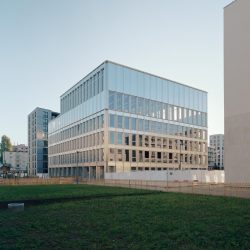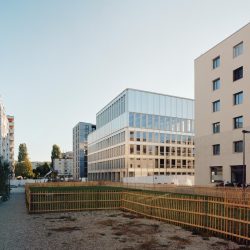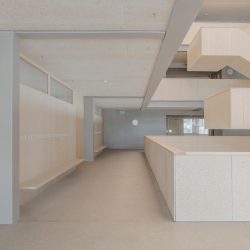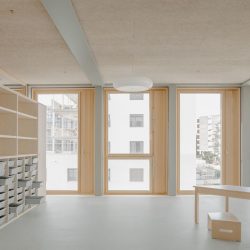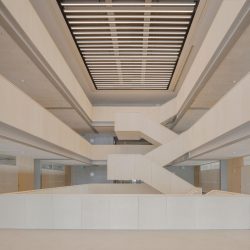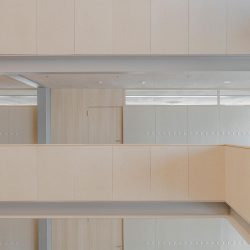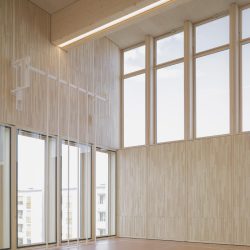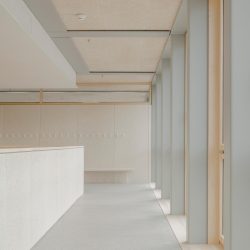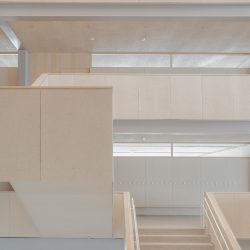
AEBY PERNEGER & ASSOCIES . photos: © Giorgio Marafioti
A neighborhood school, a public building, a landmark, the project seeks to be all of these at once, in a timeless architecture, animated during the day and evenings by the rooftop placement of the gymnasiums.
The organization of the project is motivated by a desire for verticality, reduction of excavations, and structural simplification. This initial decision led to all the subsequent ones, with the size of the sports facility determining the floor plans dimensions. Its depth allows for organizing two rows of classrooms and frees up a central space where cascading flights of stairs unfold. The supporting system combines steel, wood, and concrete, each used for their intrinsic qualities. Concrete is used for the partial basement and emergency staircases. Steel forms a three-dimensional grid organizing the entire volume, while wood, in the form of massive slabs, fills the areas defined by the linear structure.
This project is the result of a competition for an urban fragment that brings together several programs: housing cooperatives, a medico-social establishment, and a neighborhood school. Our proposal establishes a form of balance between the interests of the various clients and those of the residents and users. It emphasizes community living, facilitates interactions among residents, and encourages intergenerational interactions through adaptable public spaces.
The school is designed with a simple layout to encourage ownership by both students and the teaching staff. It is structured around a large circulation area that allows for improvisation of educational activities outside the classroom.
The spatial organization of the vertical distribution provides all students and teachers with visibility throughout the entire volume. This approach diminishes floors division of the individuals and promotes a sense of “living together”.
The school is built using as little material as possible and with a strong focus on grey energy. Its supporting structure combines three materials—wood, steel, and concrete—used sparingly while leveraging their intrinsic qualities. The wooden slabs are crafted from trees sourced from forests in the city of Lausanne and processed in the canton of Vaud. Excavation work is minimized due to the placement of the double gymnasium on the roof.
This project brings us back to a long-gone era, when economy was driven by resourcefulness and material efficiency achieved through high labor-intensive design and implementation. The pursuit of a form of frugality and lightness, achieved through strict constructional rationality, demanded a strong commitment from all involved parties: workers, architects, engineers, and the client. This demanding process unified energies and generated a beautiful enthusiasm.
The diversity of generations, cultures, and uses is highlighted by the chosen urban form. At the heart of the neighborhood, the school’s playground serves as an urban square. The location, adjacent to the school, the medico-social establishment (EMS), and its restaurant terrace, all promote intergenerational gatherings.
The significant space dedicated to non-school users of the gymnasiums, overlooking the neighborhood, and the library, open to the neighborhood residents, reinforces the public nature of the building.
The site is located in the suburbs of Lausanne, densely populated by large housing complexes built in the 1960s. This urban design centered around individual mobility is now being reconsidered. The new neighborhood, where the school is situated, will be served by a new metro line expected by 2026. It offers a morphology of streets and squares but without cars (parked in a silo garage at the neighborhood’s entrance).
This school is located in a place whose history is yet to be written. A brickyard once stood there, followed by a large parking lot. Today, a new neighborhood is unfolding, and the initial inhabitants are tentatively exploring its potential. Cars are prohibited, and vegetation is gradually taking space. What poetic disorder will disrupt the initial order ? The inevitable entropic process that follows the planners will reveal it to us.
Beauty is pursued with a sense of naivety in this project. There are no structural feats or extravagant materials; instead, there’s a return to a form of objectivity. The pursuit of the right proportions, the readability of the structure, and the honest expression of materials confine this quest within the strict realm of architecture.
The intelligibility of the construction promotes the mental ownership of the building by passersby and its users, initiating a form of sympathy.
_

